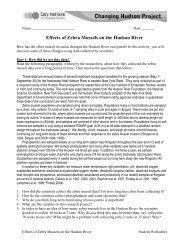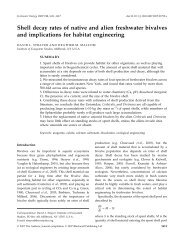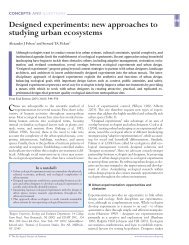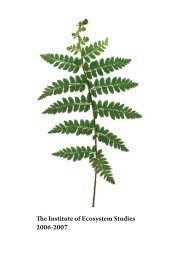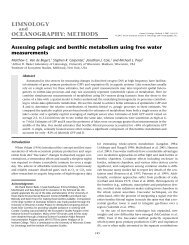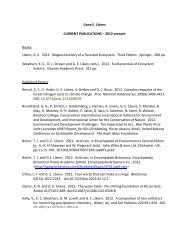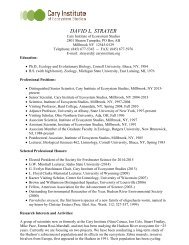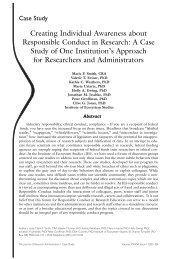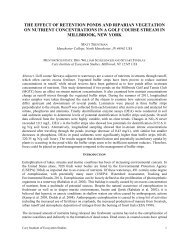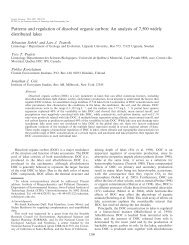variables, and this effect is largest at low values of r (Fig.6B). Add<strong>in</strong>g immigration also affects the relationshipbetween n and the steady state values of the statevariables at low values of the parameter, but themagnitude of the effect is much larger (Fig. 6C). Thedifferences between the steady state values of the statevariables <strong>in</strong> the model with and without immigrationbeg<strong>in</strong> to decrease at n/d. For all values of all threeparameters, the effect of add<strong>in</strong>g immigration (at i/0.1)is to reduce the proportion of P* while <strong>in</strong>creas<strong>in</strong>g theproportion of A* and D*.Partial recovery modelAdd<strong>in</strong>g a fourth patch type to the model causes severalimportant changes to the behavior of the model.Increas<strong>in</strong>g d causes A* to decrease steadily and F* to<strong>in</strong>crease steadily while D* and P* reach a maximum at<strong>in</strong>termediate values of d (Fig. 7A). Not surpris<strong>in</strong>gly,<strong>in</strong>creas<strong>in</strong>g r causes D* to decrease (Fig. 7B). Interest<strong>in</strong>gly,vary<strong>in</strong>g r only results <strong>in</strong> a slight <strong>in</strong>crease <strong>in</strong> P*except at low values of r presumably because patches <strong>in</strong>the P state are quickly transformed <strong>in</strong>to A account<strong>in</strong>gfor the <strong>in</strong>crease <strong>in</strong> A* as r <strong>in</strong>creases. Increas<strong>in</strong>g r has anegative effect on F*, particularly at low values of r. Atvalues of n/d, F* and P* steadily decrease as n<strong>in</strong>creases while A* and D* <strong>in</strong>crease (Fig. 7C). Increas<strong>in</strong>gr has a negligible effect on A* and D*, and servesprimarily to <strong>in</strong>crease F* while decreas<strong>in</strong>g P* (Fig. 7D).Vary<strong>in</strong>g z, the degree of discrim<strong>in</strong>ation aga<strong>in</strong>stpartially recovered patches relative to fully recoveredpatches, causes the most <strong>in</strong>terest<strong>in</strong>g changes <strong>in</strong> thesteady state values of the state variables. Increas<strong>in</strong>g z,or caus<strong>in</strong>g the eng<strong>in</strong>eer to prefer sites <strong>in</strong> the partiallyrecovered state to fully recovered patches, causes bothA* and D* to <strong>in</strong>crease (Fig. 7E), presumably s<strong>in</strong>ce itessentially <strong>in</strong>creases the number of patches that areavailable to colonization. Interest<strong>in</strong>gly, <strong>in</strong>creas<strong>in</strong>g zcauses F* to decrease. This is because, as the will<strong>in</strong>gnessof eng<strong>in</strong>eers to colonize partially recovered patches<strong>in</strong>creases, partially recovered patches tend to be colonizedand converted to active patches before they canfully recover. P* shows a unimodal relationship with z,with a maximum at <strong>in</strong>termediate values of z. Thisrelationship represents a balance between the direct<strong>in</strong>crease <strong>in</strong> the rate at which P is converted <strong>in</strong>to A andthe <strong>in</strong>direct effect of <strong>in</strong>creas<strong>in</strong>g A on the production of P(via an <strong>in</strong>crease <strong>in</strong> D) as z <strong>in</strong>creases. At both highervalues of d and lower values of n, the peak <strong>in</strong> P*, occursat lower values of z.Although this model is significantly less analyticallytractable than the simpler models, under certa<strong>in</strong> conditions,the system behaves essentially like the simplesystem discussed above. Specifically, as r approaches 1,particularly at values of z close to (or greater than) 1, theFig. 7. Dynamics of steady state values for state variables of thecomplex (4-patch) model <strong>in</strong> response to changes <strong>in</strong> the modelparameters. In simulations where they were held constant, d/0.21 (A), r/0.25 (B), n/0.39 (C), r/0.01 (D), and z/1.21(E).OIKOS 105:2 (2004) 343
Fig. 8. Effect of vary<strong>in</strong>g the rate of recovery from partiallyrecovered patches (P) to fully recovered patches (F) and level ofpreferences for previously used versus fully recovered habitat (z)on the difference between the simple (3-patch) model andcomplex (4-patch) model <strong>in</strong> the steady state proportion of activepatches (A). Values of z greater than one <strong>in</strong>dicate a preferencefor previously used habitat. In all simulations, d/0.21, r/0.25and n/0.39.values of the state variable at steady state approach thoseof the simple model with the same parameters (Fig. 8).DiscussionModel predictionsThe three versions of the model presented here producequantitatively different predictions about the proportionof eng<strong>in</strong>eered <strong>landscape</strong>s <strong>in</strong> different habitat types as theparameters are varied. However, all three models agreeon several important qualitative predictions abouteng<strong>in</strong>eered <strong>landscape</strong>s (Table 2). Landscapes will tendto have large proportions of active patches (A) when<strong>ecosystem</strong> eng<strong>in</strong>eers are efficient <strong>in</strong> their resource use,produc<strong>in</strong>g many new colonists while only graduallydegrad<strong>in</strong>g the resources of the patch, and when resourcerenewal occurs rapidly after eng<strong>in</strong>eers abandon a site.Eng<strong>in</strong>eers that create <strong>landscape</strong>s dom<strong>in</strong>ated <strong>by</strong> abandoned(D) patches would produce large numbers ofcolonizers <strong>by</strong> rapidly deplet<strong>in</strong>g the resource levels of apatch, and leav<strong>in</strong>g abandoned patches that recover veryslowly. In most respects, the proportion of potential sites<strong>in</strong> the simple model (P) reacts to changes <strong>in</strong> theparameters <strong>in</strong> a manner similar to the proportion offully recovered sites (F) <strong>in</strong> the more complex model.Ecosystem eng<strong>in</strong>eers that create patches that producefew new colonizers and are abandoned quickly, yetrecover rapidly should create <strong>landscape</strong>s dom<strong>in</strong>ated <strong>by</strong>these fully recovered patch types. In <strong>landscape</strong>s bestdescribed <strong>by</strong> the partial recovery model, partiallyrecovered patches (P) will be most abundant whenabandoned patches rapidly recover to a state sufficientto allow recolonization, but only slowly regenerate to thefully recovered state.In many cases, sites currently used <strong>by</strong> <strong>ecosystem</strong>eng<strong>in</strong>eers, and those recently abandoned are easilydist<strong>in</strong>guished from patches that have not been <strong>modified</strong><strong>by</strong> eng<strong>in</strong>eers. For example, pocket gophers form dist<strong>in</strong>ctmounds of loose soil <strong>in</strong> many prairie <strong>ecosystem</strong>s (Huntlyand Inouye 1988), grizzly bears create extensive patchesof tilled soil <strong>in</strong> alp<strong>in</strong>e meadows while forag<strong>in</strong>g for lilybulbs (Tardiff and Stanford 1998), tilefish and grouperexcavate mar<strong>in</strong>e sediments (Coleman and Williams2002), and leaves occupied <strong>by</strong> shelter-build<strong>in</strong>g Gelechiidcaterpillars are strik<strong>in</strong>gly tied together, Lill and Marquis2003. Because these states are readily identifiable, itshould be feasible to compare the relative abundance ofdifferent patch types <strong>in</strong> <strong>landscape</strong>s where the sameeng<strong>in</strong>eer operates, but where values of the parametersare likely to be different (e.g. predation risk is higherthus lower<strong>in</strong>g the number of successful colonizers, orproductivity is higher, there<strong>by</strong> speed<strong>in</strong>g up recovery fromabandoned sites). Such an analysis would serve as acritical test of whether these models successfully capturethe relationship between the population <strong>dynamics</strong> of an<strong>ecosystem</strong> eng<strong>in</strong>eer and the <strong>dynamics</strong> of the patches itcreates.Differences between modelsAdd<strong>in</strong>g a fourth patch type to represent habitat that ispartially recovered, yet still capable of be<strong>in</strong>g eng<strong>in</strong>eereddoes not alter the fundamental patch <strong>dynamics</strong> of themodel. In both the orig<strong>in</strong>al and partial recovery versionsof the model, the proportion of the <strong>landscape</strong> that willbe <strong>in</strong> the active and degraded states at steady state reactssimilarly to changes <strong>in</strong> the parameters d, r, and n.Furthermore, the steady state proportion of potentialpatches (P) <strong>in</strong> the simple model behaves similarly to thesteady state proportion of fully recovered patches (F) <strong>in</strong>the complex model with respect to changes <strong>in</strong> d and nTable 2. Summary of the parameter comb<strong>in</strong>ations that lead to high relative abundance of each of the patch types <strong>in</strong> the threemodels.<strong>Patch</strong> type 3-<strong>Patch</strong> model without immigration 3-<strong>Patch</strong> model with immigration 4-<strong>Patch</strong> modelA / r, n;¡/ d / r, n;¡/ d / r, n;¡/ dD / n; ¡/ r; <strong>in</strong>termediate d / d, n;¡/ r / n; ¡/ r; <strong>in</strong>termediate dP / d; ¡/ n / d, r; ¡/ n, i / r; ¡/ n, r; <strong>in</strong>termediate d, zF N.A. N.A. / d, r;¡/ r, n,z344 OIKOS 105:2 (2004)



